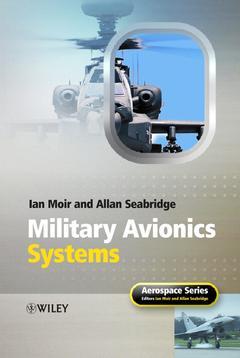Military Avionics Systems Aerospace Series
Auteurs : Moir Ian, Seabridge Allan

Military avionics is a complex and technically challenging field which requires a high level of competence from all those involved in the aircraft design and maintenance. As the various systems on board an aircraft evolve to become more and more inter-dependent and integrated, it is becoming increasingly important for designers to have a holistic view and knowledge of aircraft systems in order to produce an effective design for their individual components and effectively combine the systems involved.
This book introduces the military roles expected of aircraft types and describes the avionics systems required to fulfil these roles. These range from technology and architectures through to navigations systems, sensors, computing architectures and the human-machine interface. It enables students to put together combinations of systems in order to perform specific military roles.
- Sister volume to the authors? previous successful title ?Civil Avionics Systems?
- Covers a wide range of military aircraft roles and systems applications
- Offers clear and concise system descriptions
- Includes case studies and examples from current projects
- Features full colour illustrations detailing aircraft display systems
Military Avionics Systems will appeal to practitioners in the aerospace industry across many disciplines such as aerospace engineers, designers, pilots, aircrew, maintenance engineers, ground crew, navigation experts, weapons developers and instrumentation developers. It also provides a valuable reference source to students in the fields of systems and aerospace engineering and avionics.
Acknowledgements.
About the Authors.
Introduction.
1 Military roles.
1.1 Introduction.
1.2 Air superiority.
1.3 Ground attack.
1.4 Strategic bomber.
1.5 Maritime patrol.
1.6 Battlefield surveillance.
1.7 Airborne early warning.
1.8 Electronic warfare.
1.9 Photographic reconnaissance.
1.10 Air-to-air refuelling.
1.11 Troop/materiel transport.
1.12 Unmanned air vehicles.
1.13 Training.
1.14 Special roles.
1.15 Summary.
Further Reading.
2 Technology and architectures.
2.1 Evolution of avionics architectures.
2.2 Aerospace-specific data buses.
2.3 JIAWG architecture.
2.4 COTS data buses.
2.5 Real-time operating systems.
2.6 RF integration.
2.7 Pave Pace/F-35 shared aperture architecture.
References.
3 Basic radar systems.
3.1 Basic principles of radar.
3.2 Radar antenna characteristics.
3.3 Major radar modes.
3.4 Antenna directional properties.
3.5 Pulsed radar architecture.
3.6 Doppler radar.
3.7 Other uses of radar.
3.8 Target tracking.
References.
4 Advanced radar systems.
4.1 Pulse compression.
4.2 Pulsed Doppler operation.
4.3 Pulsed Doppler radar implementation.
4.4 Advanced antennas.
4.5 Synthetic aperture radar.
4.6 Low observability.
References.
5 Electrooptics.
5.1 Introduction.
5.2 Television.
5.3 Night-vision goggles.
5.4 IR imaging.
5.5 IR tracking.
5.6 Lasers.
5.7 Integrated systems.
References.
6 Electronic warfare.
6.1 Introduction.
6.2 Signals intelligence (SIGINT).
6.3 Electronic support measures.
6.4 Electronic countermeasures and counter-countermeasures.
6.5 Defensive aids.
References.
7 Communications and identification.
7.1 Definition of CNI.
7.2 RF propagation.
7.3 Transponders.
7.4 Data links.
7.5 Network-centric operations.
References.
8 Navigation.
8.1 Navigation principles.
8.2 Radio navigation.
8.3 Inertial navigation fundamentals.
8.4 Satellite navigation.
8.5 Integrated navigation.
8.6 Flight management system.
8.7 Navigation aids.
8.8 Inertial navigation.
8.9 Global navigation satellite systems.
8.10 Global air transport management (GATM).
References.
9 Weapons carriage and guidance.
9.1 Introduction.
9.2 F-16 Fighting Falcon.
9.3 AH-64 C/D Longbow Apache.
9.4 Eurofighter Typhoon.
9.5 F/A-22 Raptor.
9.6 Nimrod MRA4.
9.7 F-35 joint strike fighter.
9.8 MIL-STD-1760 standard stores interface.
9.9 Air-to-air missiles.
9.10 Air-to-ground ordnance.
Resources.
References.
10 Vehicle Management Systems.
10.1 Introduction.
10.2 Historical development of control of utility systems.
10.3 Summary of utility systems.
10.4 Control of utility systems.
10.5 Subsystem descriptions.
10.6 Design considerations.
References.
Further reading.
11 Displays.
11.1 Introduction.
11.2 Crew station.
11.3 Head-up display.
11.4 Helmet-mounted displays.
11.5 Head-down displays.
11.6 Emerging display technologies.
11.7 Visibility requirements.
References.
Bibliography.
Glossary.
Index.
Allan Seabridge is the Chief Flight Systems Engineer at BAE SYSTEMS at Warton in Lancashire in the UK. In over 30 years in the aerospace industry his work has included avionics on the Nimrod MRA 4 and Joint Strike Fighter as well as a the development of a range of flight and avionics systems on a wide range of fast jets, training aircraft and ground and maritime surveillance projects. Spending much of his time between Europe and the US, Allan is fully aware of systems developments worldwide. He is also keen to encourage a further understanding of integrated engineering systems.
Date de parution : 04-2006
Ouvrage de 544 p.
17.3x24.9 cm



